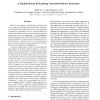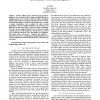579 search results - page 57 / 116 » Policies, Models, and Languages for Access Control |
CCS
2008
ACM
13 years 10 months ago
2008
ACM
The specifications of an application's security configuration are crucial for understanding its security policies, which can be very helpful in security-related contexts such...
SP
2002
IEEE
13 years 8 months ago
2002
IEEE
We introduce the RT framework, a family of Rolebased Trust-management languages for representing policies and credentials in distributed authorization. RT combines the strengths o...
ACSAC
2006
IEEE
14 years 2 months ago
2006
IEEE
With the recent advent of dynamically extensible software systems, in which software extensions may be dynamically loaded into the address space of a core application to augment i...
ACSAC
2009
IEEE
14 years 3 months ago
2009
IEEE
— The first edition of Java (both the language and the platform) was released in 1995, which contained the all-ornothing security access model. A mid-1997 paper I published in IE...
SDMW
2004
Springer
14 years 2 months ago
2004
Springer
Abstract. Researchers have recently begun to develop and investigate policy languages to describe trust and security requirements on the Semantic Web. Such policies will be one com...


